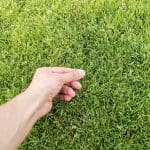
It seems like everyone is in attack mode these days and our industry isn’t spared. Lately, lawns have come under attack in the media and on social media from people who don’t understand how they fit into a healthy ecosystem and benefit the environment.
As we well know, turfgrass is a hard-working member of the ecosystem that benefits our urban and suburban spaces in many ways. If our grass lawns were reduced or eliminated, our climate change challenges would significantly increase. We would face higher air temperatures in our towns and cities; there would be more carbon dioxide in the atmosphere, and less oxygen, too. Rainfall would run off instead of infiltrating the ground, flooding would increase, and there would be more air pollution overall.
To share that message, NALP will launch a national campaign this spring to help set the record straight and you can help too. Our free National Lawn Care Month toolkit provides resources to help members promote the benefits of lawns and natural turfgrass.
Spread positive messages about the benefits of healthy lawns. Our friends at the Lawn Institute (a partner in National Lawn Care Month) offer great statistics about the benefits of natural turfgrass.
Lawns produce a lot of oxygen. One 5,000-square-foot grass lawn can produce enough oxygen daily to support 14 to 34 people. (The Lawn Institute)
Lawns trap carbon dioxide. Carbon modeling of a suburban home on a half-acre lot, with landscape beds, shrubs, trees, and a grass lawn, indicates that the lawn is responsible for most (between 81 percent and 90 percent) of the carbon captured in the yard. (The Lawn Institute)
Lawns clean the air. In a recent research study of a typical metropolitan area, low and medium-density residential lots account for over 50 percent of carbon captured in urban green spaces. (The Lawn Institute)
Lawns keep cities and towns cooler. Plants, including natural turfgrasses, act like air conditioners due to a naturally occurring cooling process known as evapotranspiration. Lawns can be up to 60 degrees cooler than the surrounding pavement. (The Lawn Institute)
Lawns help reduce flooding and filter pollutants. Grass lawns provide ecosystem services, including water filtration, sediment reduction, runoff control, flood control, and reduction in pollutants. In fact, the presence of natural grass has been shown to reduce runoff and soil losses from erosion from 6 to 18 times greater than bare soil. (Lawn Institute)
Lawns increase home values. It’s estimated that a well-maintained lawn Increases a home’s value by 10-15 percent, according to The Lawn Institute. And that may be because 79 percent of America say that a lawn is an important feature when renting or buying a home, according to a National Association of Landscape Professionals’ consumer survey.
And, hey, the future is bright. Technology is making lawn care more efficient with fewer inputs and emissions needed to care for our nation’s green spaces. So care for our nation’s lawns with pride!
This article was published in the March/April issue of the magazine. To read more stories from The Edge magazine, click here to subscribe to the digital edition.


